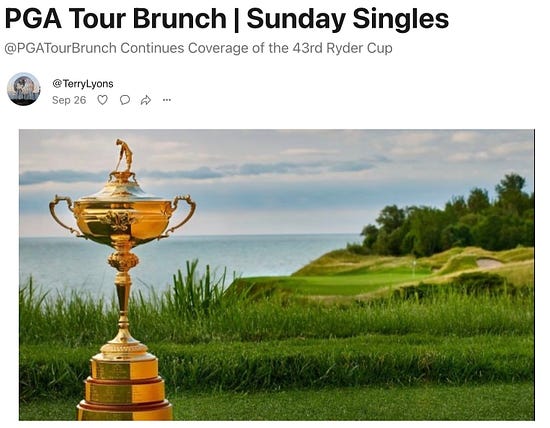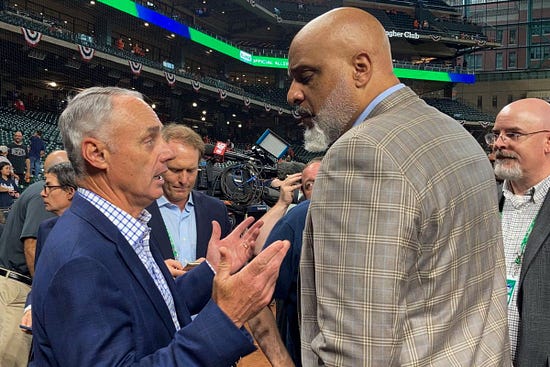While We’re Young (Ideas)
DIGGIES 2022 and Suggestion Box for Baseball
By TERRY LYONS
BOSTON – Back by popular demand, we give you the very first “DIGGIES 2022,” the top start-ups, new companies and other assorted things to anticipate with great expectations in 2022. One thing you can be assured of, Theranos will NOT be on the list.
To begin, we’ll start you off with a “Lucky 7” DIGGIES in sports investments.
Guru.Club – Remember where you “heard it first,” as Guru Club will be making a major impact in dozens of verticals, including sports, ticket sales, and everything associated with the industry. The Boston-based brand loyalty and new wave/social advertising start-up has very reasonable prices and room for growth for all brands.
HYDROW – Boston-based HYDROW is to rowing as Peloton is to cycling, complete with a monthly fee/membership to experience new and innovative content. HYDROW has been a product, engineered and marketed to the very serious “Head of the Charles” level rower. CEO Bruce Smith competed and coached in the Head of the Charles and 2015 World Championships.
Nex/Homecourt – Parent company Nex has two products and one is Homecourt, an application that allows young basketball players to train smarter, learn from the pros, and gear their training while improving skills that are applicable to NBA Combine level. Nex investors include Samsung, Blue Pool Capital, Harris Blitzer Sports Entertainment, Alibaba Entrepreneurship Fund, NBA, soccer great Thierry Henry, WNBA and USA Basketball legend Sue Bird, Harvard star and NBA phenom, now playing in China Jeremy Lin, former NBA MVP and current Brooklyn Nets coach Steve Nash, baseball legend Albert Pujols, actor and entrepreneur Will Smith, Steven Chen, co-founder YouTube, Matt Mullenweg, Co-Founder WordPress, RohamGharegozlou, Founder, Dapper Labs, NBA TopShot, Mark Cuban, team owner, Dallas Mavericks, and executives from Facebook, Uber, YouTube, Disney, and MasterClass.
PGA TOUR Brunch – A brand you’ve read about before in this column, the six days a week e-News to your Inbox is designed to give PGA Tour fans a mobile-first, and mobile-friendly tournament previews, betting odds, news updates and the most important links to content to save you time as you read the news on your device over lunch, brunch or whenever. Compiled and written by this reporter (Terry Lyons) who enjoys weekly competition in a couple Fantasy Golf leagues, too. Sign-Up or gift PGA TOUR Brunch to your favorite golfer or PGA TOUR fan and receive a special 205 discount by visiting HERE. (Notification: PGA Tour Brunch is not affiliated with the Tour and is a publication by Digital Sports Desk and TERRY LYONS)
Real Response – Real Response is designed to help sports organizations empower their student-athletes and give them the tools needed as the marketing world changes via Name, Image and Likeness opportunities (and eventual regulation). RealResponse partners with over 100 collegiate institutions and athletic organizations like the NFL Players Association, and USA Gymnastics. Through surveys, real-time reporting, and a comprehensive documentation repository, Real Response provided over 50,000 athletes a safe space to deliver concerns and feedback to their administration(s) and reps.
ShotTracker – A ‘not too’ oldie but goodie, here, Shot Tracker is growing its influence. ShotTracker is a sensor-based system that automatically captures statistical and performance analytics for (mostly men’s and women’s basketball) teams in real-time. Up-to-the-minute shot charts, optimal lineups, box scores in game, all streaming instantly into coaches and/or video assistants hands. the late David Stern was on it early, via Greycroftinvestment arm, and now Magic Johnson, Seventy-Six Capital and a host of others are onboard.
Too Good To Go – A global start-up from Europe, now expanding in the USA. They work with Restaurants, Bakeries, Grocery Stores and Households to combat the waste of good food. There’s certainly a future application for sports venues, caterers, and vendors.
HERE NOW, THE NOTES: Between college and pro basketball, a few Bowl games, a slew of NHL games, along with airline flights, there’s been more cancellations than a postmaster detailing stamps at the Post Office. Everyone from bus drivers to vendors to NBA referees are quarantining after positive tests from any and all variants of the COVID-19 virus, but somehow, the band plays on.
Schedule makers in the NHL might have an easier time making up lost games, as they now have the gap in the original schedule, pre piously being held for the 2022 Winter Olympic Games. … College conferences will struggle mightily to find dates to reschedule games and we’re already seeing games that were previously planned to be played in the big time sports arenas, now being relegated to the small on-campus gyms. That’s bad for season ticket holders, but possibly good for added home court advantage but the idea of seeing a packed house in Seton Hall’s tiny Walsh Gymnasium screams super-spreader.
THE BOWLS: The concept, formerly known as the College Football Bowl Season, is in deep trouble. Not only are teams cancelling because of COVID-19 concerns (which is unavoidable at this point in time), but the changing tides of college football result more and more in bowl teams arriving without their head coach, a defensive coordinator (who took on a job opportunity elsewhere) or star players who opt-out of the bowl game to work with professional trainers and strength and conditioning coaches to better prepare for the NFL Combine and Draft.
This column tries best not to be by-lined by Captain Obvious, but a MAJOR change needs to be made and the powers-that-be in college athletics and college football need to act now, rather than later.
There is no simple solution.
One thought is to expand the College Football Playoff system from four to 16 teams and draw a line in the turf right there. Only 16 college football teams would qualify for post-season and four pods of four teams each would be established to create a “Final Four” scenario that we currently enjoy.
Purists – a.k.a. lovers of the Bahamas Bowl, the Tailgreeter Cure Bowl or the Jimmy Kimmel Bowl – might lament. The option there would be to create a college football version of the “National Invitational Tournament” (NIT) and have an “on-campus” game or two to create the NIT Final Four which could be played in the likes of Dayton Ohio or Las Vegas.
The NCAA would also have to create a “No Fly Zone” or moratorium against the hiring or firing of college football coaches from November through January 15.
Michigan and Georgia at the Orange Bowl (Photo by Jeff Goldstein)
DIAMOND DUST-UPs: If the College Bowl Season is broken in two, Major League Baseball has been smashed to pieces.
Currently in lock-out mode, MLB players are working-out on their own and have 42 days until Pitchers & Catchers report for Spring Training. Negotiations are on-going for a new Collective Bargaining Agreement to govern the sport for years to come and the process might become quite painful for both team owners and players.
There are drastic steps that need to be taken in the next agreement. Here are a few:
- SALARY CAP SYSTEM: MLB, like football, basketball and hockey before it, must negotiate a Salary Cap (minimum and maximum team salary structure) to govern the Majors. Unless on-field miracles occur, there’s easily 15-20 MLB teams that have little to no chance of competing for a World Series title. Every year, there’s one or two surprise teams that might make the Wild Card playoffs and ride a “hot” pitching or a few “hot” bats, but for the most part, the system is so broken, only the big time teams can compete. A Salary Cap system seems unavoidable, but the MLB Players Association will fight, claw and scream their way out of any collective agreement that includes team salary limits, and curtailing the free agency market.
- RULES: MLB must address the designated hitter, the extra-inning rules brought on by COVID-19, including seven-inning doubleheaders and the man-on-second-base rule for extra innings. I’d go with the DH in both leagues and that would be a major “get” for the Union as the jobs of aging players unable to play the field would be protected for all 30 teams. On the others, I’d lean hard against the seven-inning twin bills and the “man-on-second-base” rule. Additionally, there needs to be major change in the way relief pitchers are being utilized. While the purists can claim that MLB managers should be able to do whatever it takes to win a ballgame, the use of eight-to-10 pitchers every game is excessive and the TV audience simply tunes out. The DH should go one way or the other. In or out. (It’s currently only in the American League and has been since 1973. That’s 49 years of inequity. … The pace of play also comes in under the area of game rules that need to be addressed in the CBA. Recent reports have noted the Office of Baseball and the MLB Players have been meeting/discussing non-economic or core issues. Here’s a “Six/Fix” for Baseball:
- Suggestion One: No mound visits in the first three innings unless a pitcher is going to be removed from the game. (Of course, MLB Trainers can assist a pitcher if there’s an injury from a come-backer).
- Suggestion Two: Limit the number of pitchers to be ‘active” for any one game. Ten or 12 pitchers max. Others can be healthy scratches, ready for the next game.
- Suggestion Three: Limit shifting. Each position would have a range of space where the defensive players can be positioned. The range could be on electronic notification that would “beep” in a players’ fielding glove if he approached his space limitation area.
- Suggestion Four: Address bench-clearing. Bench clearing brawls in Baseball are often no more than pushing-shoving or square-dancing, but there’s always the potential for an all-out “Rudy T” moment and serious injury. There is NO REASON players should leave the dugout. a minimum 20-game suspensions would take care of it. Second offense? How about 50 games?
- Suggestion Five: Bench clearing from the bullpen is just ridiculous. It’s the easiest fix of the bunch. If a reserve pitcher/catcher/coach leaves a bullpen area during an altercation, Baseball should be able to suspend the player for 50 games.
- Suggestions Six: (This might sound ridiculous, but a cumulative 10-15 minutes every game is spent as batters nervously re-adjust their batting gloves for every pitch). Once a player steps in the batter’s box, he can no longer adjust his batting gloves. Period. First infraction, a warning. Second infraction? Off come the batting gloves for the rest of the game.
MLB Commissioner Rob Manfred and MLB Unit Exec Director Tony Clark






